Chemistry and Mineralogy tool rover Curiosity
At 61 sol (Martian day), his stay on Mars Curiosity first scooped up a handful of sand with its 7-centimeter bucket and prepared to send it to the depths of its scientific body. A two-day hitch, with a piece of plastic discovered on the surface of Mars, suspended work, but the matter was continued.
In order to prepare soil samples, a special CHIMRA (Collection and Handling for In-Situ Martian Rock Analysis) device is located on the manipulator. It is a bucket of 4x7 centimeters, a tube that will divert the stone chips from the drill, several internal containers, a vibromechanism and a sieve, with a cell of 150 microns.
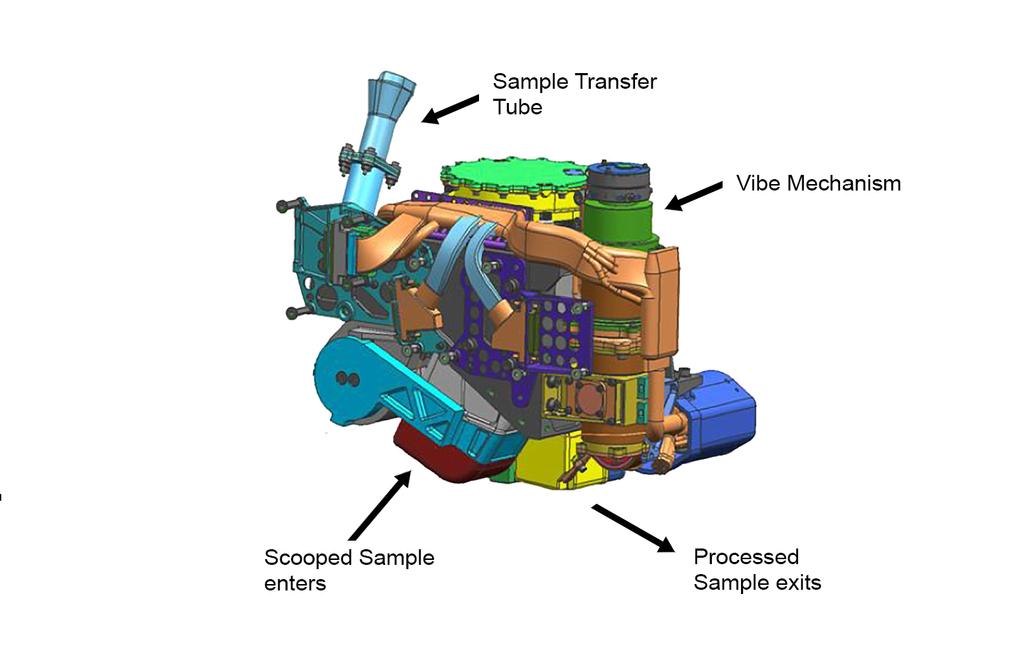
After the bucket scoops up soil, the first part of the sample is taken from it. In the internal cavities of CHIMRA it is sifted through a sieve, which helps the operation of the vibromechanism, the excess is removed, and the next portion is sent for sifting. In total, there are three stages of picking from the bucket and sifting the soil. As a result, there remains a little powder of the required fraction, which is sent to the soil receiver, on the body of the rover, and excess is thrown out.
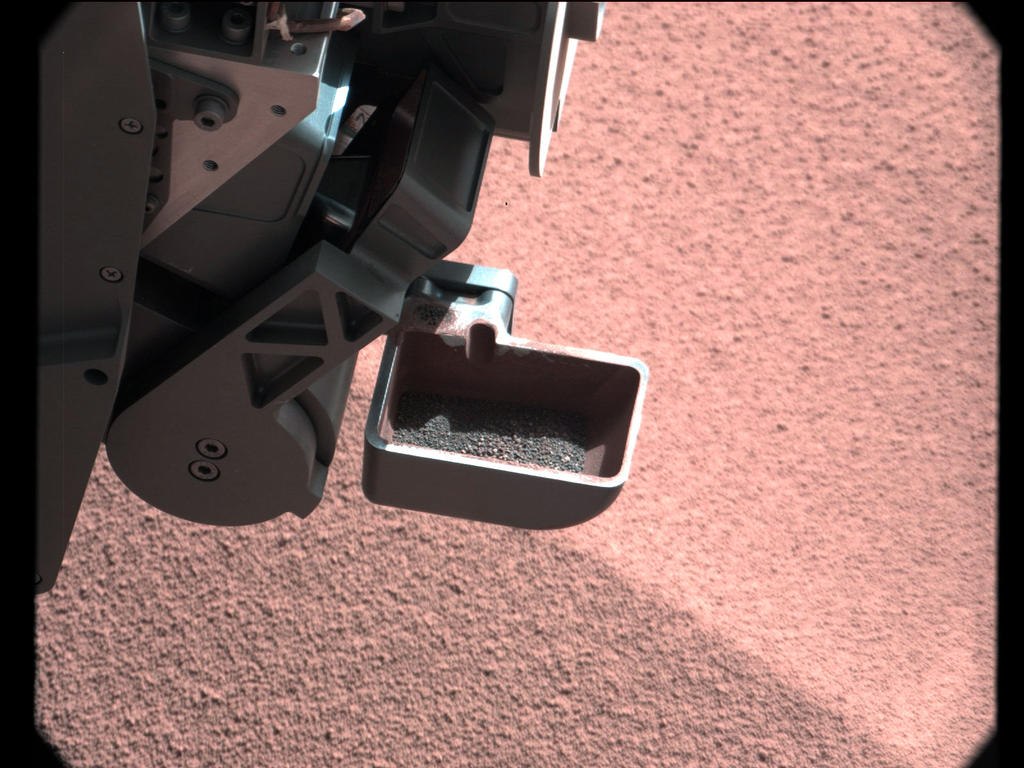
(color adjusted by NASA)
As soon as Curiosity prepared the first sample, the next one was scooped up.

The “second attempt” is not an accident. Two devices are located inside the body of the rover, for the study of Martian soil.
One of them, the Chemistry and Mineralogy instrument or ChemIn for short, will determine the mineral composition of Martian rocks.
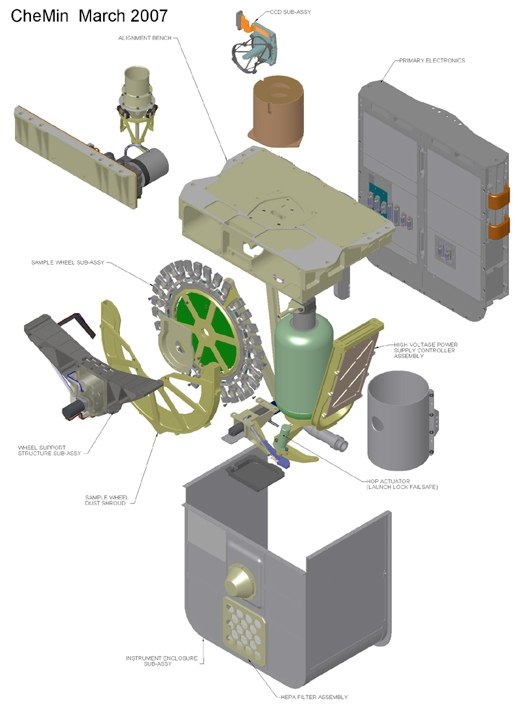
(cylinder with compressed air, for blowing device elements and cleaning from foreign particles of soil)
The mineral composition will show scientists under what conditions the rocks appeared, which means it will tell about the geological periods in the history of Mars. First of all, scientists are interested in those rocks that were formed with the participation of water. For example, gypsum contains water, but anhydrite, also having a chemical structure, does not. Allegedly, gypsum was encountered along the path of the Opportunity rover, but it did not have the necessary equipment on board for accurate identification.
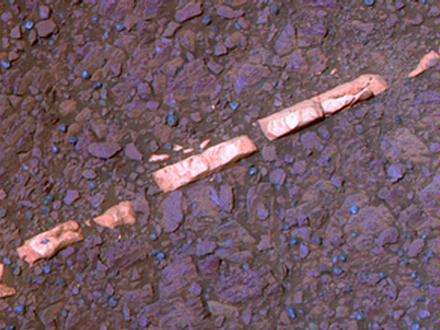
That is, ChemIn will look for mineral clues on those conditions that could contribute to life on Mars.
ChemIn conducts a study using an X-ray beam the thickness of a human hair, directing its flow to soil samples. Results will be evaluated by two methods.

The first is X-ray fluorescence. Samples irradiated with x-rays will begin to glow, and atoms of different substances will each do this with their own intensity.
The second method is X-ray diffraction. The X-ray, passing through the rock crystals, will be deflected in them, at an angle determined by the structure of the crystal lattice of the mineral. Scientists already know the diffraction patterns of almost all minerals, so they can only get the result and compare with what they have.
Information on the luminosity of atoms and the diffraction pattern will be captured by a specially prepared E2V CCD-224 matrix 600x600 pixels in size and information from it will be sent to Earth.

For the matrix, the optimal operating temperature is -60 ° C. If the temperature is higher, then the picture from the neutron generator of the Russian DAN device will clog the picture.
The ChemIn X-ray process is provided using a wheel, on which 32 round cells for samples are located, with a diameter of 8 mm and a thickness of 175 microns.
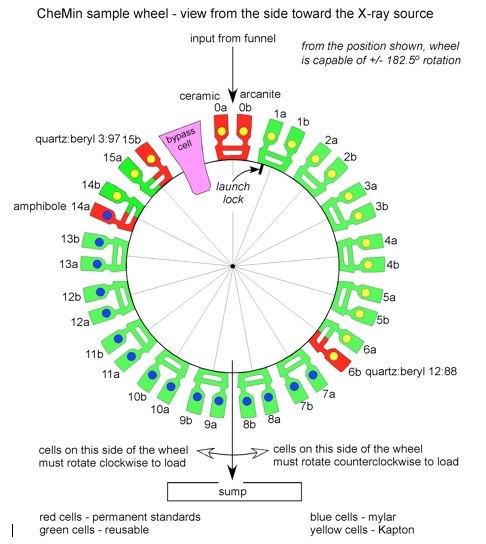
On each "petal" of the wheel there are two cells. There are two types of cells, which differ in the material of the transparent wall, through which the beam will fall on the mineral. One type is made of Mylar ( Vic ), the second of Kapton ( Vic ).
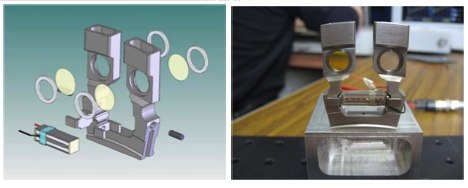
These films differ from each other in physical properties. Mylar provides a clearer diffraction pattern, but it is sensitive to vibration and acid exposure. Kapton is more reliable and durable, but introduces its “noise” into the diffraction pattern, which is especially harmful when studying clay minerals.
Only 27 cells are available for Martian samples, and 5 are occupied by test samples placed on Earth. They are necessary to test the functionality of the device in Martian conditions. But empty cells - reusable - they are cleaned when the wheel is rotated 180 degrees.
The work of CHIMRA and ChemIn is shown in NASA's Curiosity demo when the rover itself was still in the assembly hall. The moment starts at 9:08
Curiosity has another instrument inside called SAM (Sample Analysis at Mars), but it will require a separate story.
PS And, yes, I use VK as a picture host, because upload them to my Curiosity group. If anyone has a problem with this - write, do not be shy.
In order to prepare soil samples, a special CHIMRA (Collection and Handling for In-Situ Martian Rock Analysis) device is located on the manipulator. It is a bucket of 4x7 centimeters, a tube that will divert the stone chips from the drill, several internal containers, a vibromechanism and a sieve, with a cell of 150 microns.

After the bucket scoops up soil, the first part of the sample is taken from it. In the internal cavities of CHIMRA it is sifted through a sieve, which helps the operation of the vibromechanism, the excess is removed, and the next portion is sent for sifting. In total, there are three stages of picking from the bucket and sifting the soil. As a result, there remains a little powder of the required fraction, which is sent to the soil receiver, on the body of the rover, and excess is thrown out.

(color adjusted by NASA)
As soon as Curiosity prepared the first sample, the next one was scooped up.

The “second attempt” is not an accident. Two devices are located inside the body of the rover, for the study of Martian soil.
One of them, the Chemistry and Mineralogy instrument or ChemIn for short, will determine the mineral composition of Martian rocks.

(cylinder with compressed air, for blowing device elements and cleaning from foreign particles of soil)
The mineral composition will show scientists under what conditions the rocks appeared, which means it will tell about the geological periods in the history of Mars. First of all, scientists are interested in those rocks that were formed with the participation of water. For example, gypsum contains water, but anhydrite, also having a chemical structure, does not. Allegedly, gypsum was encountered along the path of the Opportunity rover, but it did not have the necessary equipment on board for accurate identification.

That is, ChemIn will look for mineral clues on those conditions that could contribute to life on Mars.
ChemIn conducts a study using an X-ray beam the thickness of a human hair, directing its flow to soil samples. Results will be evaluated by two methods.

The first is X-ray fluorescence. Samples irradiated with x-rays will begin to glow, and atoms of different substances will each do this with their own intensity.
The second method is X-ray diffraction. The X-ray, passing through the rock crystals, will be deflected in them, at an angle determined by the structure of the crystal lattice of the mineral. Scientists already know the diffraction patterns of almost all minerals, so they can only get the result and compare with what they have.
Information on the luminosity of atoms and the diffraction pattern will be captured by a specially prepared E2V CCD-224 matrix 600x600 pixels in size and information from it will be sent to Earth.

For the matrix, the optimal operating temperature is -60 ° C. If the temperature is higher, then the picture from the neutron generator of the Russian DAN device will clog the picture.
The ChemIn X-ray process is provided using a wheel, on which 32 round cells for samples are located, with a diameter of 8 mm and a thickness of 175 microns.

On each "petal" of the wheel there are two cells. There are two types of cells, which differ in the material of the transparent wall, through which the beam will fall on the mineral. One type is made of Mylar ( Vic ), the second of Kapton ( Vic ).

These films differ from each other in physical properties. Mylar provides a clearer diffraction pattern, but it is sensitive to vibration and acid exposure. Kapton is more reliable and durable, but introduces its “noise” into the diffraction pattern, which is especially harmful when studying clay minerals.
Only 27 cells are available for Martian samples, and 5 are occupied by test samples placed on Earth. They are necessary to test the functionality of the device in Martian conditions. But empty cells - reusable - they are cleaned when the wheel is rotated 180 degrees.
The work of CHIMRA and ChemIn is shown in NASA's Curiosity demo when the rover itself was still in the assembly hall. The moment starts at 9:08
Curiosity has another instrument inside called SAM (Sample Analysis at Mars), but it will require a separate story.
PS And, yes, I use VK as a picture host, because upload them to my Curiosity group. If anyone has a problem with this - write, do not be shy.
